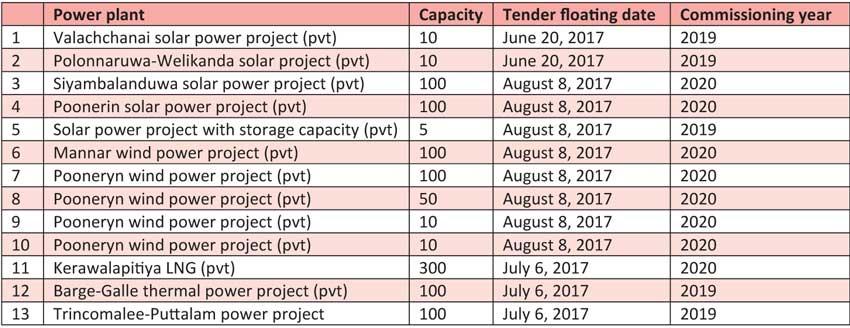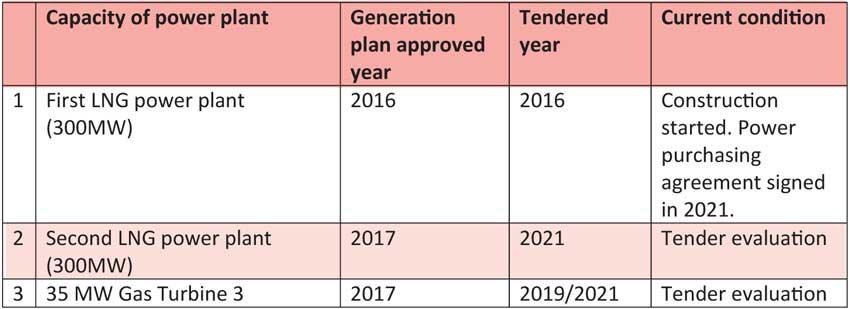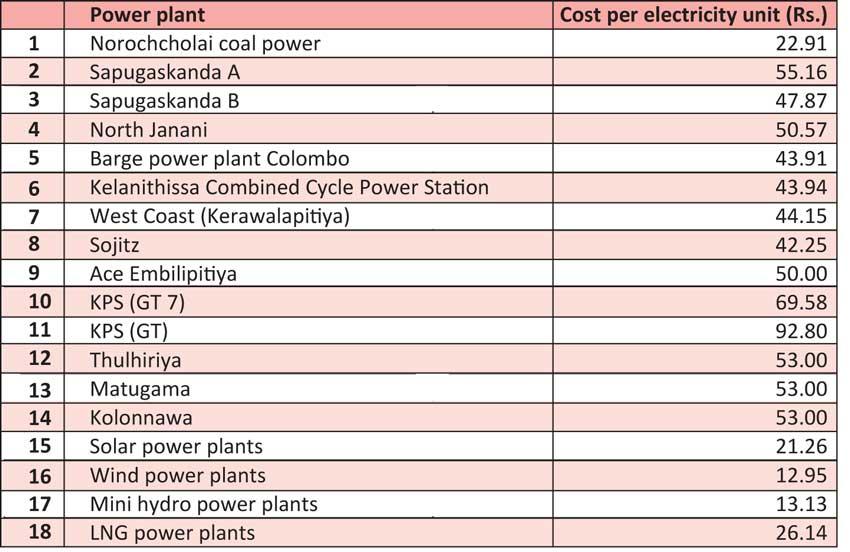A Brief Colonial History Of Ceylon(SriLanka)
Sri Lanka: One Island Two Nations
A Brief Colonial History Of Ceylon(SriLanka)
Sri Lanka: One Island Two Nations
(Full Story)
Search This Blog
Back to 500BC.
==========================
Thiranjala Weerasinghe sj.- One Island Two Nations
?????????????????????????????????????????????????Friday, April 8, 2022
Documents leaked to Daily Mirror reveal what went wrong in Sri Lankan power sector
7 April 2022
When the lights went out on March 31 many Sri Lankans would hardly have been surprised. Rationing of electricity has grown commonplace in recent years, particularly since March of this year, when a foreign currency shortage produced a fuel crisis and reservoir levels fell owing to dry weather.
The Government has offered a variety of explanations for the blackouts, ranging from dollar shortage to COVID-19 pandemic. In fact, the pandemic interrupted economies of many countries. However, evidence shows that Sri Lanka’s power problem is the result of more than a decade of corruption and inept power system management.
Analysts anticipate that a global shift to renewables such as solar and wind will support developing countries to strengthen their economies. Alternative energy has a low environmental impact as well. The Paris Agreement, a binding pact that requires states to make specific pledges to reduce climate change, has been signed by nearly 200 countries, including Sri Lanka. Where is Sri Lanka’s renewable energy during a power crisis like this?
Delays in implementing already planned and approved projects are stifling Sri Lanka’s renewable energy capacity growth, jeopardizing President Gotabaya Rajapaksa’s so-called aim of 70% renewable energy by 2030. He said he will urge the state-run Ceylon Electricity Board (CEB) to draft a long-term generation plan in accordance with the ‘Vistas of Prosperity and Splendour.’ The strategic plan was formulated. But, what really happened to the plan? Why wasn’t it put into action?
The Public Utilities Commission of Sri Lanka (PUCSL) compiled an explanation report in the third week of March that detailed everything that went wrong in the country’s renewable energy sector. The Daily Mirror was able to obtain a copy of the report, and as part of our mission to educate the public with their right to accurate information, we have included passages from it below.
The report signed by Janaka Ratnayake, Chairman of the PUCSL was sent to the Assistant Auditor General S. T. B. Ratnayake on March 18 in response to a letter sent by the Auditor General’s Department on March 14. Copies of this report have also been sent to Ministry of Economic Policies and Plan Implementation.
- Publicising policy guidelines was required under Section 5 of the Sri Lanka Electricity Act No. 20 of 2009. It has, however, been postponed.Despite the fact that the government declared its renewable energy policy in 2019 (a target of 70% renewable energy), it was publicised only in October, 2021 as the Electricity Act states.
- The long term generation plan for 2021 has not been formulated in line with government policy by the CEB. The PUCSL has instructed the CEB to formulate it according to the government policy. The CEB has requested that it be given time until June, 2022 to prepare it.
What is the current status of Long-Term Generation Expansion Plan 2015-2034?
- Prepared by the CEB to be implemented within the next 20 years starting from the year 2015
- Approved by the PUCSL in 2016
- The Secretary to the Ministry of Power and Energy has also instructed the CEB to construct the relevant power plants without any delay.
- On June 29. 2017, the CEB board of directors gave their approval as well.
The tender dates for the plants, as well as the period during which the plants shall commence operations, are shown below.

- Although 400 MW of renewable energy projects were scheduled to be constructed between 2015 and 2020, only the 100 MW Mannar wind power plant was completed in 2021 and commenced generating electricity.
- Construction of the Kerawalapitiya LNG Power Plant commenced a year later to the proposed date.
- All other power plant projects haven't even been tendered on schedule.
What happened to Long-Term Generation Expansion Plan 2018-2037?
- The PUCSL gave its approval for the said plan on July 19, 2017.
Given below is the list of powerplants scheduled to be built from 2018 to 2022 according to the plan.

- Altogether 1137 MW renewable energy projects and 875 MW thermal power plants have been delayed.
Where did foreign-aid energy projects end up?
1. 500 MW natural gas power plant project – Japan
- The Secretary to the Power Ministry and the Secretary to the Economic, Trade and Industry Ministry of Japan signed the MOU on August 18, 2018.
- As per Paragraph 43 of Sri Lanka Electricity Act, the Cabinet approval was granted on September 5, 2018.
2. 500 MW natural gas power plant project – India
- Sri Lanka and India signed the MOU on April 26, 2017.
- Cabinet approval was granted on September 5, 2018.
3. 400 MW natural gas power plant project - China
- Cabinet approval was granted on September 5, 2018.
- Attorney General gave approval to the MOU draft on October 18,2019 but, the MOU was not signed between the two countries.
Much-delayed power plants
Only the following three powerplants were tendered from the approved thermal powerplants for the period from 2014 to 2022.

2018-2037 Generation Expansion Plan approved by the PUCSL recommended to increase the contribution of renewable energy to 60% by 2030. A goal to complete 1000MW solar power projects by 2020 was identified under Soorya Bala Sangramaya project (Battle for Solar Energy).
- However, calling tenders for the following large-scale renewable power plants approved by the CEB in 2017 was delayed for five years. The tender process is yet to commence in 2022.
 |
What’s the big deal about the Southern Province grid?
Emergency power purchases: Plaster for the deep wound
The CEB has made 17 requests to the PUCSL during the period from 2017 to 2022 to purchase emergency power and 16 of them were declined by the Commission.
One of the main reasons for opting for emergency power purchases, on the below mentioned dates, according to the CEB, is that it would provide solutions to issues in the Southern Province grid.
1. May 2, 2016
2. April 1, 2016
3. April 4, 2018
4. April 5, 2018
5. September 28, 2018
6. March 4, 2021
7. March 9. 2022
- A 100 MW thermal power plant was approved to be built as a solution to the issues in the Southern Province in 2016.
- The Cabinet sub-committee appointed in 2016 highlighted the importance of completing the facility as soon as possible.
- This facility was also approved by the CEB director board in 2017.
- However, no action has been taken yet to build the low-cost power plants as a long-term solution to the problem in the Southern Province.
Construction delays of transmision network
Constructing the following transmission cables planned to strengthen the power supply network in the Southern Province was delayed for more than five years.
- Ambalangoda–Galle 132kV transmission cable included in the 2013 Transmission Development Plan was constructed in 2017 and is yet to be connected to the national system.
- Construction of Polpitiya–Hambantota 220kV transmission cable included in the 2013 Transmission Development Plan was supposed to be finished in 2017 as planned. But, it is still not complete.
- Construction of Kotmale–Polpitiya 220kV new transmission cable included in the 2013 Transmission Development Plan was supposed to be finished in 2017 as planned. But, it is still not complete.
- Construction of Horana–Padukka 220kV transmission cable included in the 2017 Transmission Development Plan was supposed to be finished in 2021 as planned. But, it is still not complete.
Increasing power cost
Thermal power plant costs has been rapidly increasing over time, surpassing the costs of renewable energy power plants. The current cost of each power plant is listed below.

- CEB’s production and distribution cost per one electricity unit was Rs. 30 in February 2022. The estimated cost per unit in March 2022 is Rs. 36.10. This cost is likely to increase with the depreciation of the rupee.
| What needs to be done? |
Attempts to enhance power capacity in accordance with policies and plans have failed for years. This predicament has arisen as a result of the CEB’s current structure’s flaws and issues. The CEB, which was created under the Ceylon Electricity Board Act No 17 of 1969, currently holds a monopoly on 70% of electricity generation, 85% of distribution, and 85% of power transmission.
|
1. Establishing financially independent business units/ institutes for the licenses issued to the CEB to generate, transmitand distribute.
2. Appointing chief executive officers in charge of these independent business divisions’ aims, including earnings.
3. Establishing necessary business units/institutes for each licensee and transferring power plant procurement and electrical system management responsibilities.
4. Independently managing the financial sources regarding agreements to purchase, transmit and sell power.
5. Prohibiting officers of three upper management levels of the CEB becoming trade union members to prevent trade unions manipulating the CEB management.
6. Establishing separate business units/ institutes to purchase power and to control systems.

